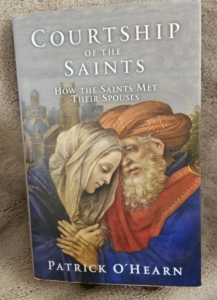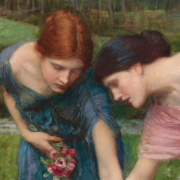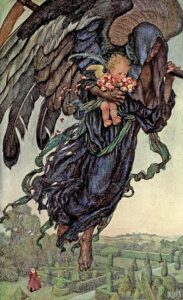Love Among the Saints
Love Among the Saints
Do we think of saints being married? Among the most popular — St. Therese, St. Francis, St. Pio of Pietrelcina, St. Teresa of Calcutta were wed to Christ and the church. Yet Catholic history proclaims saintly husbands and wives who lived lives much like the rest of us. Who could ever imagine that the father of one of the most scholarly popes would have crafted a newspaper ad to find his wife? Or that a couple, now on their way to sainthood, would have a story that rivals Romeo and Juliet in family drama? Only one husband lived not just to testify to his wife’s saintliness but also to be present at her canonization. Another saint married twice. And one husband literally tried the patience of a saint.
Patrick O’Hearn’s Courtship of the Saints: How the Saints Met their Spouses, offers lively, loved-filled accounts of couples from Biblical times into the 21st Century. They shaped the church in some way through their sacrifice and devotion to one another and to their families by making the prayer their foundation and God the center of their lives.
into the 21st Century. They shaped the church in some way through their sacrifice and devotion to one another and to their families by making the prayer their foundation and God the center of their lives.
Mr. O’Hearn, also the author of Parents of the Saints: The Hidden Heroes Behind Our Favorite Saints, and former acquisitions editor with Tan Books, clearly strives to provide an antidote to the decades old “hookup culture” that has degraded marriage, women, and men. He does this with inspirational examples of a proven formula for meeting one’s true love. People have, over the centuries, continued to seek love, but the ways of going about it have failed. He promises that the contents lying beyond the beckoning cover of the intimate painting, “The Meeting of Joachim and Anne outside the Golden Gate of Jerusalem,” by Fillipino Lippi (1497) are “… better than any romantic novel because they return to the source of love: God Himself” (p. 5), and Mr. O’Hearn is as eager as any evangelist to share the news.
He doesn’t begin there, however, because without the proper framework, the stories would only be pretty romance tales. Mr. O’Hearn commences by defining courtship and its significance, offering historical and contemporary perspectives. He explains how it is different from modern “dating” and urges those called to marriage to pursue it. “Our culture will only be renewed when the family is strong … when marriages reflect Christ’s radical love for His church; when couples love each other madly through the good times and bad, and are open to the number of children God wants to provide them.” (pp. 5-6). He peppers the narrative with quotes from Ven. Fulton Sheen, St. Thomas Aquinas, and other well-known and favored theologians.
“Courtship looks to the future – to eternity,” he explains. “Courtship asks the following questions: Does this person have virtue? Is this the best person to lead me — and, God willing, my future children — to heaven?” (p. 11). He moves into betrothal: “…a time for a couple to intensify their prayer life as they prepare for marriage” (p. 19). Introspective questions give further substance to the book and to Mr. O’Hearn’s premise of returning to a prayer-filled, God-invited relationship. Part Two “Courtship Counsel and Prayers” is a kind of action plan that offers contemplative questions such as: How do I pray daily for my future spouse? Where should I look for a future spouse? It also advises how to choose a spouse, discern marriage as a vocation, and offers prayers and saintly inspirational quotes. A section for married couples opens with this guidance: “Rediscover why you fell in love in the first place and continue to fall in love. Don’t let the fire burn out.” Mr. O’Hearn then suggests practical applications for doing so.
Sandwiched between the practical is the romantic with the couple’s entertaining encounters. The 23- year union between Karol and Emilia Wojtyla so influenced their young son that it helped to shape his perception of the love between a man and a woman that the author asserts it “… provided the first education concerning the splendor of marital love” contained in Pope St. John Paul II’s “Theology of the Body.” His parents are now Servants of God. Accounts like the Wojtylas will melt hearts. Others might drop jaws, such as the meeting of Josef and Maria Ratzinger that occurred when she responded to a newspaper ad he wrote to find a wife. St. Thomas More transitions from the martyr who dared to defy King Henry VII to the guy down the street who is widowed prematurely and, out of concern for his young children, begins looking for a wife. No doubt readers will chuckle – because they know a couple just like this — when they read about Bl. Anna-Maria Taigi and her husband, Dominic, who possessed “rough” manners.
Others will bring tears. Arguably, no other romance is as beautiful as that between Pietro Molla and Gianna Beretta and the family life they created. The author devotes nearly 20 pages to them. Anyone who has read Journey of Our Love: The Letters of Saint Gianna Beretta and Pietro Molla, which the author cites, will marvel at how he was able to keep it to 20.
Among the 25 couples, readers will have many favorites because, regardless of the time, all have uniqueness and relatability. Each one also has the commonality of fervent prayer and love of God. Anyone willing to put their love life into God’s hand will be able to find joy, endure hardships, and withstand suffering, proving that but no one can write a love story better than the Father Himself.
© Copyright 2025 by Mary McWilliams
Feature Photo by Eugenia Remark: https://www.pexels.com/photo/decorated-cards-golden-plate-and-ring-in-box-14784845/
Inset photo by Mary McWilliams

 Photo by Eugenia Remark: https://www.pexels.com/photo/decorated-cards-golden-plate-and-ring-in-box-14784845/
Photo by Eugenia Remark: https://www.pexels.com/photo/decorated-cards-golden-plate-and-ring-in-box-14784845/



